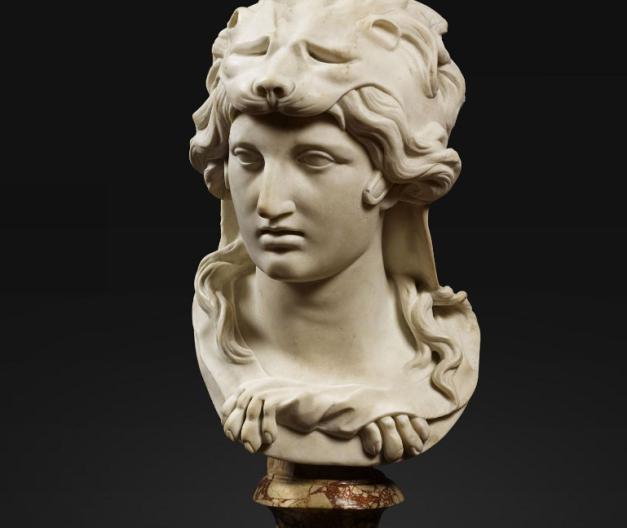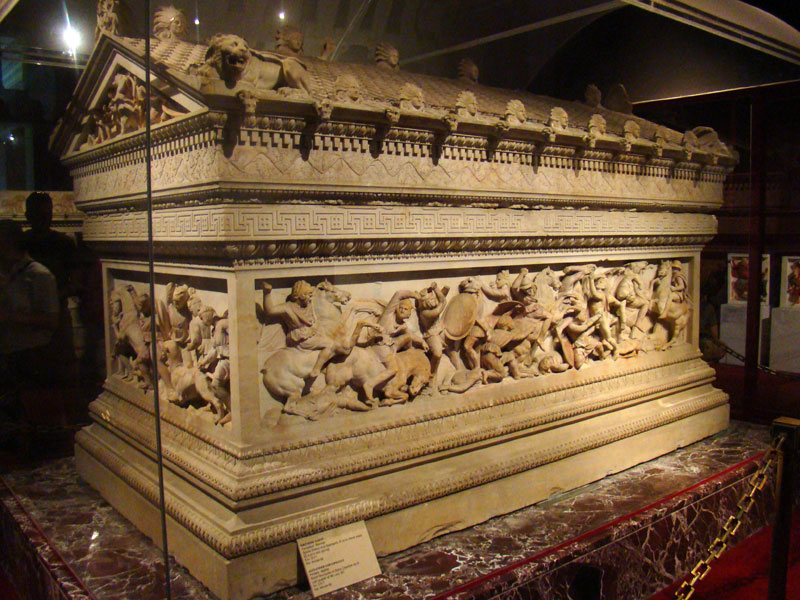In world history, as in the Pandora's box, many secrets and legends are kept. One of such mysterious pages in history is considered the secret of the grave and helmet of Alexander the Great. The helmet is used by the authors as an attractive element for the plots of works of various art forms. For example, it is this helmet that the “gentlemen of luck” are looking for from the film of the same name by Alexander Sery. This cinematic "helmet" is stored in the exposition of the Mosfilm museum and is made of the usual fire helmet of past centuries.
Helmet of Alexander the Great: legends and myths
The name Alexander in Persian sounds like Iskander or Two-horned. And this is understandable. After all, according to legend, his helmet was to be crowned with a ram decorated with the horns of the gods, which is probably connected with the ancient heraldic symbol of Macedonia - the image of a goat on the banner of the Macedonian kings.

According to legend, the golden helmet was given to Alexander the Great by the god of sunlight, the patron of the arts Apollo. It was such a valuable treasure that the Macedonian coast was like the apple of an eye: he did not take it with him on military campaigns, much less use it for its intended purpose - he left it at home. A strong guard remained near the vault. During the absence of Alexander in the country, the helmet served as a talisman for the state and its inhabitants. Shortly before death, during an Indian campaign, the commander was faced with the fierce resistance of the Indian nobles and their troops. He sent messengers to Macedonia to bring a helmet, in the hope of his miraculous power. However, the helmet could not even protect itself: on the way to the army, the ambassadors of Alexander of Macedon were robbed by robbers. This happened in an area called Pyatigorye, located on the Mineralovodsk sloping plain in the northern part of the Caucasian Mineral Waters region.
The robbers were caught and subjected to terrible torture. Even at the edge of life, they chose to remain silent and did not give out where they had hidden the helmet. It is believed that he was hidden in one of the suitable crevices. The helmet was never found, and Alexander was forced to leave India. It is still unknown where the helmet of Alexander the Great is stored, and historians continue to search for it.
Mystery of the tomb of Alexander the Great: Alexandria of Egypt
In 2017, 2340 years passed since the death of the famous commander of antiquity. But it is still unknown where he is buried. The main contender is considered to be the resting place of the commander Alexandria.
After death, the body of 33-year-old Alexander the Great was embalmed by Egyptian priests, specially called for the ceremony, and left for two years in the palace chambers. The inherited throne, Ptolemy did not fulfill the testament of Macedon to bury him on the green land of the oasis of Siwa in the Egyptian desert, because he was outside the borders of the state. And Alexander the Great for all fellow citizens personified a strong and powerful government. Ptolemy ordered to bury the great commander and warrior in the tomb in Alexandria, thereby making the city a place of pilgrimage for a huge number of people.
There is a version that initially the mourning procession was sent by Ptolemy to their possessions - to Memphis, but the priest of the temple opposed the burial of Alexander in Memphis, predicting misfortunes and bloody battles in case of disobedience. Then the body of the great commander of antiquity continued to the land of Alexandria.
During the reign of the Roman emperor Septimius Severus, the tomb was walled up. As a result, Alexandria ceased to be a "city of cities." The tomb was so well hidden that no one could find it. However, there is a version that it is located under the mosque of the Prophet Daniel on the street of Alexander the Great.
Funeral chariot in descriptions of the past
Alexander the Great was transported to Alexandria in a marble sarcophagus, on a chariot created by the great engineer Philip. According to Ptolemy, the mourning chariot, being driven forward by 64 mules, was advancing along the immediately paved roads, because in front of it was a whole "army" of builders. Behind the chariot the army of the commander was moving: infantrymen, chariots, cavalry, even warriors on fighting elephants.
But Flavius Arrian claimed that 8 mules were harnessed to the chariot. And the chariot was made of gold, with gold rims and knitting needles. And the mules were decorated with gold crowns, bells and necklaces.
Sarcophagus: history and fiction
According to the descriptions of Ptolemy, the sarcophagus was located under the canopy between the ivory columns that adorned the chariot. The canopy was made in the form of a starry sky and decorated with precious stones. On the lid of the sarcophagus, made of gold by Philip, they put the commander’s weapon and a Trojan shield. According to the memoirs of Flavius Arrian, the canopy inside was cleaned with rubies, carbuncles, emeralds. Inside it were four paintings depicting various military units of the Macedonian army on the march: chariots, fighting elephants, cavalry and navy. Under the canopy stood a golden throne, cleaned with flowers that changed every day. And the sarcophagus, according to Arrian, was golden.

A relief was carved on the longitudinal wall of the sarcophagus, telling of the victorious battle of Alexander the Great with the Persian army led by Darius III. The battle was so fierce that piles of bodies of dead Greeks and Persians accumulated around Darius’s chariot. The midst of this battle is carved on the sarcophagus with special reliability in the transfer of vestments of soldiers, in dynamics and expression.
Grave in the desert?
The accession of Egypt by Alexander the Great to his empire took place without any particular problems, since his army was perceived as the liberator of the Egyptian people from the Persians. Eight years before his death, the commander traveled along the Nile, into the depths of the Egyptian desert, where he discovered the oasis of Siwa. Three hundred kilometers journey left the army without water, the army almost died. With difficulty, travelers reached the green island of life, where among the greenery stood the temple of the god Amon. In the temple, the priests not only blessed Alexander of Macedon, but also called him the son of Amon. This inspired Alexander to new campaigns and accomplishments, as well as to the decision to be buried on the ground of this oasis at the temple.
In 1990, Greek scientists went to Siwa and found there an amazing underground burial complex, on the reliefs of which they saw the image of the personal symbol of Alexander the Great, and on the stelae - letters written on behalf of Ptolemy, or to themselves, reporting the burial of Alexander the Great in Siwa, according to testament. The temple and the tomb were surrounded by a wall. Here were found images of lions, which were usually used in funeral rites of Greece. And everything else had little in common with Egyptian culture and was more like Macedonian structures and products.
The surviving ancient coins depict Alexander of Macedon with a headdress in the form of a lion’s head and two ram horns, which correlates with the description of the legendary helmet. In the Hermitage, the helmet of Alexander the Great exists mainly in images on ancient coins.
Replica Legendary Helmet
The history of the golden helmet of Alexander of Macedon excites the minds of people, wakes the imagination of artists. Modern jewelers created an exact copy of it. The basis was taken from his sarcophagus. Three craftsmen made it for 5 months at once from a multicomponent alloy, based on copper and zinc. Sheet thickness - 1.5 mm. All curls were knocked out with wooden hammers. This is a very hard manual labor.
Full face helmet made in the form of a muzzle of a lion. The entire helmet is initially coated with a layer of silver and then gold. Only the nose remains silver, which is coated with a special varnish so that the silver does not wear off. The helmet of Alexander the Great is inlaid with stones (tiger's eye, sapphires or moissanites), rock crystal and ivory.
The helmet suggests a size for wearing 58, but it is not known whether this size matches the exact size of the head of Alexander the Great.
The helmet is quite durable. When worn continuously, it will be stored for five years.